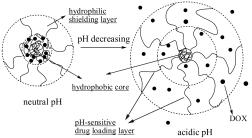1 Gao, W.; Chan, J. M.; Farokhzad, O. C. Mol. Pharm. 2010, 7(6), 1913.2 Yuan, L.; Tang, Q. Q.; Yang, D.; Zhang, J. Z.; Zhang, F. Y.; Hu, J. H. J. Phys. Chem. C 2011, 115, 9926.  3 Yuan, L.; Wang, B. D.; Tang, Q. Q.; Zhang, X. H.; Yang, D.; Hu, J. H. Chin. J. Org. Chem. 2010, 30, 640 (in Chinese). (袁丽, 王蓓娣, 唐倩倩, 张晓鸿, 张晓环, 杨东, 胡建华, 有机化学, 2010, 30, 640.)4 Prabaharan, M.; Grailer, J. J.; Pilla, S. Biomaterials 2009, 30(29), 5757.5 Bae, Y. H.; Yin, H. Eur. J. Pharm. Biopharm. 2009, 71, 223. 3 Yuan, L.; Wang, B. D.; Tang, Q. Q.; Zhang, X. H.; Yang, D.; Hu, J. H. Chin. J. Org. Chem. 2010, 30, 640 (in Chinese). (袁丽, 王蓓娣, 唐倩倩, 张晓鸿, 张晓环, 杨东, 胡建华, 有机化学, 2010, 30, 640.)4 Prabaharan, M.; Grailer, J. J.; Pilla, S. Biomaterials 2009, 30(29), 5757.5 Bae, Y. H.; Yin, H. Eur. J. Pharm. Biopharm. 2009, 71, 223.  6 Zhang, L.; Eisenberg, A. J. Am. Chem. Soc. 1996, 118, 3168. 6 Zhang, L.; Eisenberg, A. J. Am. Chem. Soc. 1996, 118, 3168.  7 Fukushima, S.; Miyata, K.; Nishiyama, N.; Kanayama, N.; Yamasaki, Y.; Kataoka, K. J. Am. Chem. Soc. 2005, 127, 2810. 7 Fukushima, S.; Miyata, K.; Nishiyama, N.; Kanayama, N.; Yamasaki, Y.; Kataoka, K. J. Am. Chem. Soc. 2005, 127, 2810.  8 Koide, A.; Kishimura, A.; Osada, K.; Jang, W.-D.; Yamasaki, Y.; Kataoka, K. J. Am. Chem. Soc. 2006, 128, 5988. 8 Koide, A.; Kishimura, A.; Osada, K.; Jang, W.-D.; Yamasaki, Y.; Kataoka, K. J. Am. Chem. Soc. 2006, 128, 5988.  9 Yang, D.; Zhang, X. H.; Yuan, L.; Hu, J. H. Prog. Nat. Sci. 2009, 19, 1305. 9 Yang, D.; Zhang, X. H.; Yuan, L.; Hu, J. H. Prog. Nat. Sci. 2009, 19, 1305.  10 Zhang, G.-L.; Ma, J.-B.; Li, Y.-H.; Wang, Y.-N. J. Biomater. Sci., Polym. Ed. 2003, 14(12), 1389. 10 Zhang, G.-L.; Ma, J.-B.; Li, Y.-H.; Wang, Y.-N. J. Biomater. Sci., Polym. Ed. 2003, 14(12), 1389.  11 Blout, E. R. J. Am. Chem. Soc. 1956, 78, 941. 11 Blout, E. R. J. Am. Chem. Soc. 1956, 78, 941.  12 Tang, G.-P.; Chen, Q.-Q. J. Biomed. Eng. 1997, 14(2), 99 (in Chinese). (汤谷平, 陈启琪, 生物医学工程学杂志, 1997, 14(2), 99.)13 William, H. D.; Drew, P. Tetrahedron Lett. 1988, 29(46), 5859. 12 Tang, G.-P.; Chen, Q.-Q. J. Biomed. Eng. 1997, 14(2), 99 (in Chinese). (汤谷平, 陈启琪, 生物医学工程学杂志, 1997, 14(2), 99.)13 William, H. D.; Drew, P. Tetrahedron Lett. 1988, 29(46), 5859.  14 Zhu, K.-L.; Tang, G.-P.; Chen, Q.-Q. Acta Pharmaceutica Sinica 1998, 33(12), 906 (in Chinese). (朱卡琳, 汤谷平, 陈启琪, 药学学报, 1998, 33(12), 906.) 14 Zhu, K.-L.; Tang, G.-P.; Chen, Q.-Q. Acta Pharmaceutica Sinica 1998, 33(12), 906 (in Chinese). (朱卡琳, 汤谷平, 陈启琪, 药学学报, 1998, 33(12), 906.)  |
